Sweeping in Norway
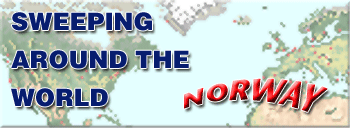
Sweeping in Norway |
 |
Sweeping in Drammen, Norwayby Arild D. Moen with Ranger Kidwell-Ross

As Chief engineer for the Municipal Enterprises in the City of Drammen, Arild Moen has seen firsthand -- and participated in -- the struggles the city has gone through with trying to combat increasing levels of pollution. Earlier, these threatened the ability of its citizens to eat fish caught in the fjord and to continue to swim and enjoy recreation in the Drammen fjord.
The city center lies at the end of a valley, on both sides of the river Drammenselva, and where the river meets the sea in Dramsfjorden (Drammens Fjord). Transport is important for the Drammen trade and industry, and the city is a junction for road, rail and ship. Drammen Port is heavily used by international shipping companies, making the city the main harbor for car and fruit imports in Norway. Drammen is also a railroad junction and an export center for one of the most productive forest districts of Norway. The food industry is prolific, and several big and small companies within the electronics and graphics industry are important sectors for employment in Drammen. While previously important industries, including the processing of wood pulp, cellulose, and paper; the mining of zinc, nickel, and cobalt; shipbuilding, and other industries have been phased out, they have left pollutants. There is now an ongoing effort to clean up the heavy metals, PBCs and organic compounds left by these industries. The number of pulp and paper industries along the Drammen River have gone down from 22 factories in the 1970s to three presently. The city made a major effort with new construction of intercepting sewer lines and treatment plants to clean up its sewerage effluent in the 1980s and finished the work in 1995. This has been celebrated every year since with the River Festival in August and the FIS World Cup Sprint Cross Country in March. You can now swim and fish for salmon in the river right in the middle of the city. Drammen is also an area thatŐs growing steadily. As of 2007 the cityŐs population was in excess of 60,000, while the greater Drammen Region has a population of 160,000. 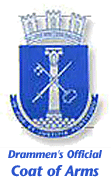
Most of the fjords lie innermost of bigger fjords and near industrial areas that have churned out some pollutants over the years. Recently, a number of these have had pollution levels -- including high levels of mercury, PCBs and lead -- high enough to make their fish and shellfish potentially dangerous for human consumption. The newspaper Dagsavisen reported in mid-July of 2007 that the country's food safety agency was advising caution in eating fish or shellfish from Drammen's fjord, as well as 33 other fjords on Norway's coastline. As a result -- plus the fact that Drammen's geography has it surrounding a river and on the sea -- Drammen officials now recognize the need to contain as much pollution as possible. Street sweeping is seen as one of the ways to accomplish this. Sweeping is used for both debris cleanup and to address pollutionIn Drammen, which is located in the eastern part of Norway, we sweep in order to get rid of debris and grit, but also to improve our air and water quality. Because of the relatively harsh climate, we face some serious chanllenges in this effort. The main challenges for the sweeping technology in Norway are the regional differences in climate that can be freezing cold but also wet during the winter. Our heavy winters mean there is an extended use of studded tires, which are large contributors to creating fine dust and wear on the pavement. Around 75% of cars use studded tires during the winter months. We also have a large number of pedestrian areas that are paved with cobblestones and stone slabs, which increases the difficulty of sweeping. In addition there can be inversions that trap the dust in cities like Oslo, Trondheim and Drammen. We utilize both mechanical broom and vacuum sweepers in Drammen. Vacuum sweepers, using water for dust suppression, are used in various sizes. Due to their better ability to pick up the finer types of dust and pollutants, this is the dominating type used for roads and streets. 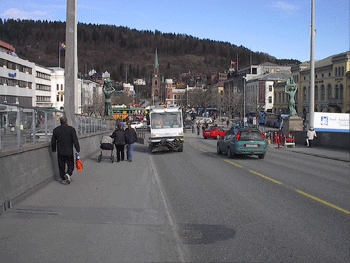
We also have some Dulevo broom sweepers, which are the ones shown in the photos, that offer low suction. These sometimes, but not always, used water for dust suppression. We use these primarily for winter sweeping, and for our pedestrian areas and airports. Both types of sweepers are mainly produced in Denmark, Sweden, Germany and Italy. On the rainy western coast of Norway grit and garbage goes down the drain immediately. Although that is what might be called 'a modified truth,' the western Norwegian city of Bergen is, because of its heavy rainfall, one of the cleanliest cities in the world. The drains are mostly of the combined type where the first flush goes to the sewage treatment plant. In addition, however, the city has many medium and small vacuum sweepers. 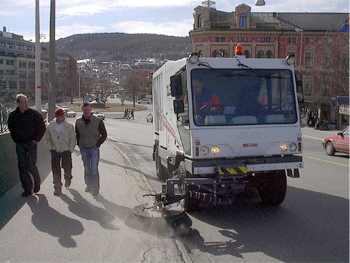
In Drammen we have had positive experiences with use of our two Dulevos. These are Italian made broom machines that are outfitted with a low pressure suction system and filters on the effluent air. We use these machines both on the main roads and in the pedestrian areas. They are especially useful in freezing weather, since they do a good job of removing a large part of the PM10 dust without use of water. We find that this fine dust is best removed when the machines are used early in the morning before the traffic starts to whirl up the dust. For example, we logged 100 tons of fine dust we removed with just one machine that was used to sweep the main roads during a 21-day winter period. That's a lot of material kept out of the air and not allowed to run off as water runoff pollution. Because of our heavy winters, afterward it is a considerable job to remove grit and sand from the streets. In Drammen, we use three or four sweepers that work two shifts throughout April and May. This job we have found is best done with traditional heavy vacuum sweepers and broom sweepers hooked on as a trailer to a lorry (large truck). We do use water for dust-suppression in this process. Drammen's pedestrian areas have several challengesCentral commercial areas reserved for pedestrian use only have been established in the old parts of the city. The total area of these has increased during the last 20 years. These areas have also seen the addition of furniture, sculptures, flowers and trees in what used to be streets with traditional driveways and sidewalks. The room between cobblestones and between granite slabs is filled with fine sand. 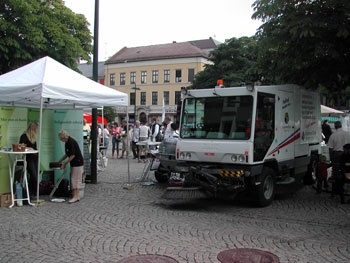
As one would expect, the traditional use of vacuum sweepers with heavy suction removes the sand that stabilizes this kind of pavement. Fortunately the Dulevos like the one shown, which are mechanical broom sweepers that also are outfitted with low suction, have solved this problem. Another challenge our sweeping team faces is cleaning up after the partying that often occurs on weekend nights. When youths leave restaurants and discos they also leave a lot of glass and garbage all over our marketplace and the central pedestrian areas. This is attacked at 6 o'clock each morning, 7 days a week, by one small and one medium Dulevo sweeper and a footman with shovel and broom. By the time the commercial business opens, or when people arrive for church on Sunday morning, everything is cleaned up. Out-sourcing is the in-trendThe Norwegian government Roads Administration and several municipalities, including Drammen and Oslo, have outsourced the upkeep of roads to private and public companies. As is often done, in Drammen the existing municipal organization was split into two separate organizations. One consists of the city hall engineers who contract out the jobs and who have the budget money. The other segment consists of the people doing the job. The latter is organized into an independent company that has to compete in the market in order to win jobs from city hall. Although the initial reorganization period was not easy, in the long term there will be savings and a more focused use of spare road resources. One effect is that the new public enterprises start looking around and ask themselves: what can we do for other customers? Drammen Municipal Enterprises (DME), which is owned by the city and previously worked only for the city, now has about 100 sweeping contracts in the city centre. Most of these are for small sections of sidewalk sweeping that are the responsibility of the property owners. DME sweeps from housewall to housewall. The bill is split between property owners and the owner of the public road. Prices and standards for the sidewalk sweeping are regulated in an agreement with the property/business association for the city centre. DME also sweeps for the harbour and in private parking areas. Unfortunately, in my view this kind of sweeping is not done often enough to prevent storm water pollution. The reason for this is money-pinching by the property owners and lack of focus on storm water pollution from the environmental regulating authorities. Over time, and as pollution problems become even more evident, I have hope that this situation will change. This will occur only when the responsible parties realize the relative overall cost savings available through removing the material before it can enter the waterways.
Arild D. Moen is Chief Engineer of Drammen Municipal Enterprises,
City of Drammen. You may reach him via email sent to: Arild.Moen@drmk.no
|